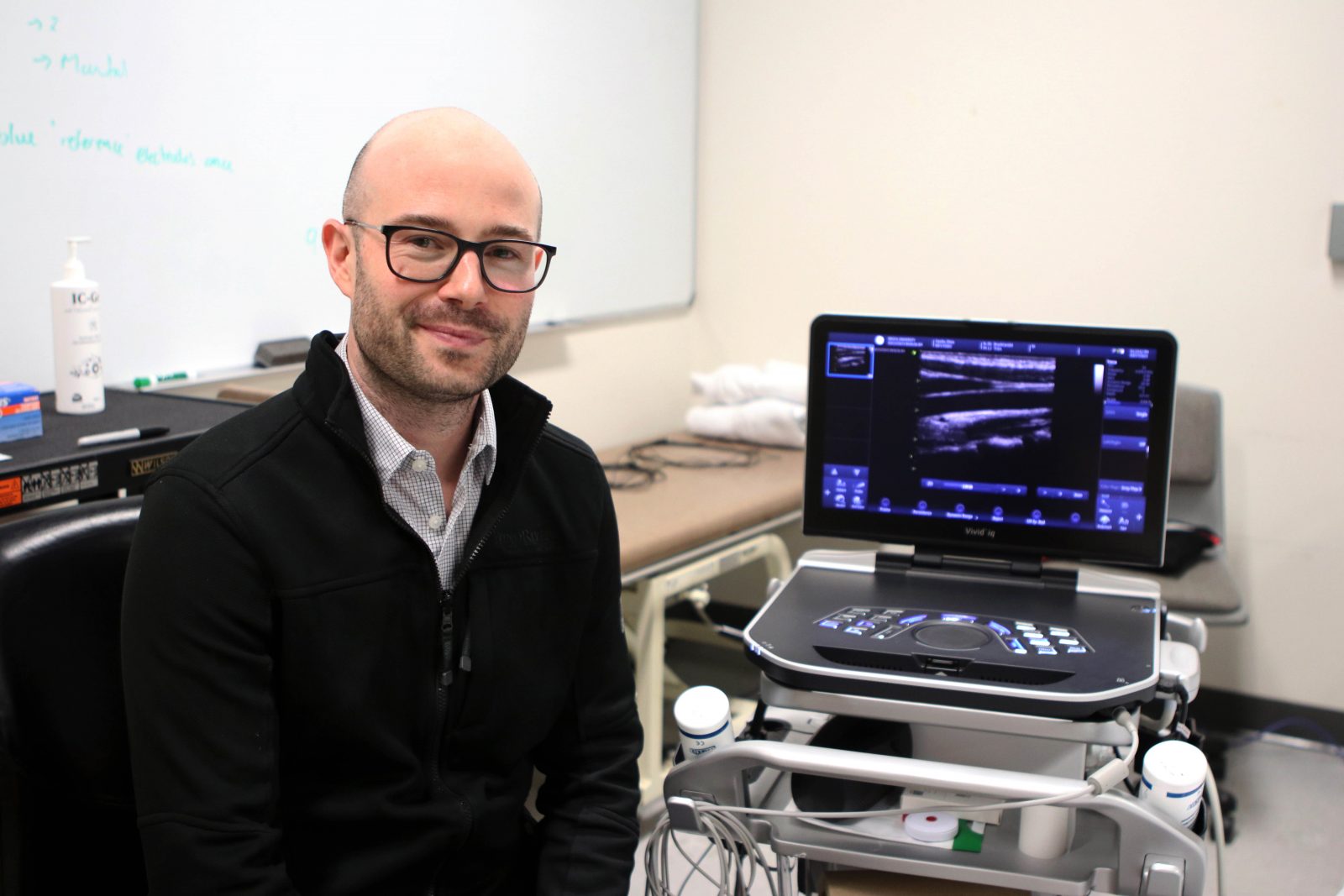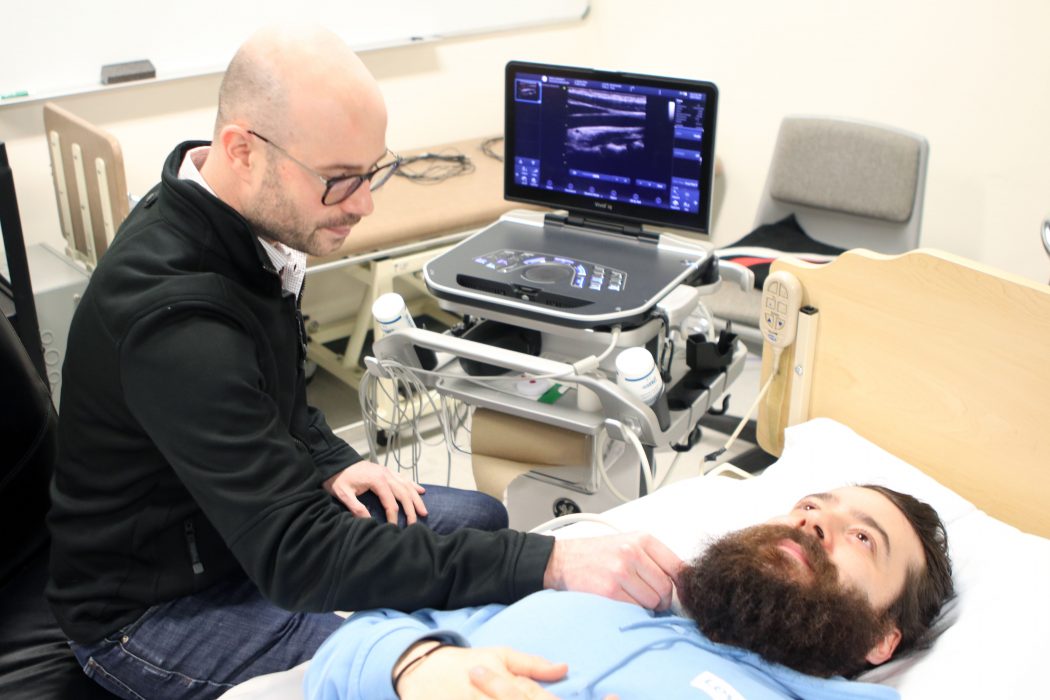 Assistant Professor of Kinesiology Stephen Klassen researches how the brain ‘talks’ to a large network of blood vessels that regulate blood pressure and blood flow in humans.
Assistant Professor of Kinesiology Stephen Klassen researches how the brain ‘talks’ to a large network of blood vessels that regulate blood pressure and blood flow in humans.Stephen Klassen is a communications specialist, but not in the usual sense of the term. He studies the language of the brain, specifically how the brain ‘talks’ to a large network of blood vessels that regulate blood pressure and blood flow in humans.
To do so, the Assistant Professor of Kinesiology uses a method called microneurography, which visualizes and records nerve impulses travelling from the brain and brainstem towards blood vessels in humans.
In his latest research paper, “Baroreflex resetting of human sympathetic action potential subpopulations during exercise,” Klassen gives new insight into how the baroreceptor reflex regulates the neural signals ‘communicating’ with blood vessels during progressively fatiguing physical exercise.
The baroreceptor reflex involves a series of steps that ensures blood pressure does not fall too low when people rapidly stand or rise too high when they are startled or perform exercise.
Baroreceptors in the arteries sense when blood pressure falls. They relay this information to the brain, which changes the neural signals towards the blood vessels and the heart.
Reacting to these signals, the blood vessels then constrict and the heart beats faster and harder, which ensures that blood pressure remains optimal. The opposite process occurs when blood pressure rises too high.
The neural messages Klassen’s lab studies are those of the sympathetic nervous system, known best for its ‘flight-or-fight’ role that elevates heart rate and regulates blood flow for oxygen delivery to help the body cope with dangerous or stressful situations.
Related to that is the parasympathetic nervous system, a process in which the brain and nerves communicate with the heart to slow heart rate and decrease blood pressure during times of relaxation.

Assistant Professor of Kinesiology Stephen Klassen (left) performs an ultrasound of the blood vessels in the neck of PhD student Nathan Iannarelli (laying on bed). Klassen and his team research the brain circulatory connection.
The new insight in Klassen’s latest baroreflex paper, pre-published March 22 in the Journal of Neurophysiology, comes from closely examining the role of ‘action potentials’ in the baroreceptor reflex.
An action potential is a rapid rise and subsequent fall of electrical currents in the membranes of neuron and muscle cells. This process means the neuron is ‘firing’ and ‘communicating.’
“Action potentials are the most basic strategy used by our neurons to ‘communicate’,” says Klassen. “Previously, studies had not looked this deeply into the neural messages directed towards the blood vessels in the context of baroreflex regulation during exercise.”
Due to the activity of action potentials, Klassen and his team found that the baroreceptor reflex strongly controls only some, but not all, sympathetic neurons communicating with blood vessels during exercise in humans.
“We will continue our exploration to understand the unknown pathways that control other sympathetic neurons during exercise,” says Klassen.
The research team also found that the strength of baroreflex control over human sympathetic neurons can be changed during exercise.
“When muscle becomes fatigued during exercise, it sends signals to the brain that increase baroreflex control of some of our sympathetic neurons controlling blood vessels,” says Klassen.
“On the other hand, areas in our brain that control how much effort we are putting in during exercise might reduce the baroreflex control of sympathetic neurons communicating with blood vessels,” he says.
This latest research adds to the ways Klassen is expanding research in his field. For instance, in another study, Klassen and his team used a new approach to record participants’ nerve activity and found that previous studies may have been underestimating the amount of sympathetic neural signals towards human blood vessels by about 30 percent, in young healthy participants.
“This previous study provided us with a more complete picture of the language that the brain uses to communicate with our blood vessels to control our blood pressure and keep us alive,” says Klassen.
Klassen, who is a research collaborator at Mayo Clinic in Minnesota, conducts what is known as ‘fundamental research.’ This type of research develops a greater understanding of how natural processes work or improving scientific theories.
Last year, he received a grant from the Natural Sciences and Engineering Research Council of Canada (NSERC) to examine the mechanisms the sympathetic nervous system uses to control the cardiovascular system.
“My NSERC-funded research will improve our basic physiological understanding of neurocirculatory regulation,” says Klassen.
“Also, this research has implications for better understanding the development of cardiovascular risk factors and cardiovascular diseases such as hypertension and coronary artery disease, as the sympathetic nervous system plays a critical role in their development,” he says.
Klassen is scheduled to present the results of his ongoing research at the American Physiological Society Conference in Long Beach, California in April this year.
Kinesiology Professor making inroads in the brain-circulatory connection - Brock University
Read More

No comments:
Post a Comment